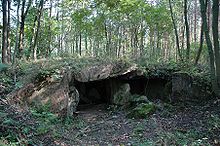Schill group of works
The Schill work group is one of the 13 work groups on the Oder-Warthe-Bogen fortress front .
description

South of the Ludendorff group of works , southeast of the town of Kurzig (Kursko / Poland), there is the “SCHILL” group of works of the central section of the Oder-Warthe-Bogen fortress front. The group of works consisting of works 757 and 754 had the task of defending the Meseritz (Międzyrzecz) –Kurzig (Kursko) road and the Meseritz– Zielenzig (Sulecin) railway line . Furthermore, even a so-called part "Hindenburg-state" which Panzerwerk 755 to this group of works, which as part of Nischlitz-Obra line the swing bridge D 724 , which on the tactical channel 725 had led to cover.
The two armored plants 754 and 757 were designed in the expansion stage B old (1.50 m wall thickness) and are connected by a hollow corridor in which there are barracks and rooms with technical facilities.
Works
Panzerwerk 757 (Pzw 757)
The Pzw 757 is a two-story entrance building. It was equipped with two six- notch turrets of the type 20 P7 for two machine guns and an M19 machine grenade launcher in armored tower 424 P01, an armored tower for infantry observers and an FN device (fortress close combat device = fortress flamethrower ).
Panzerwerk 754 (Pzw 754)
This plant is a small two-storey facility with a six- notch turret 20 P7 for machine guns , an M19 machine grenade launcher in tank turret 424 P01 and a small infantry observation bell 23 P8 . Access to this work was only possible underground via the tunnel, as it did not have an above-ground access.
MG and PaK stand 755 (Hindenburg stand)
Plant 755 was built in 1935. The armament of this plant consisted of a machine gun behind a steel notch plate type 10 P7 and a 3.7 cm PaK 36 . The PaK could be driven out to field position 755. The underground barracks are two-story and the individual rooms are separated from each other by brickwork.
After the end of the war, the works of the Schill group were badly damaged by the Red Army when they were blown up and the built-in armored parts such as armored domes or notch plates were almost completely removed. However, the entire hollow corridor with its room layout is in a good state of preservation.
literature
- Dieter Bettinger, Martin Büren: The West Wall. The history of the German western fortifications in the Third Reich. 2 volumes. Biblio-Verlag, Osnabrück 1990, ISBN 3-7648-1458-6 .
- Kurt Burk: The German state fortifications in the east 1919–1945. Biblio-Verlag, Osnabrück 1993, ISBN 3-7648-2425-5 .
- Marcin Dudek, Jerzy Sadowski, Sebastian Rosenbaum: Pancerze fortyfikacji niemieckich z lat 1934–1941. Atlas Pancerzy. = Panzer Atlas. inforteditions, Gliwice / Gleiwitz 2006, ISBN 83-922687-1-7 .
- Günther Fischer: The fortress front Oder-Warthe-Bogen and the tunnel system Hochwalde. In: publication series fortress research. 7, 1988, ISSN 0723-2039 , pp. 175-200.
- Jörg Fuhrmeister: The new tank atlas. 2 volumes. Studienkreis Interfest eV, Saarbrücken 1996–1997, ( Fortification Special Edition 4).
- Anna Kędryna, Robert M. Jurga: Grupa Warowna. Oraz staniswisko dla km-u za plyta pancerna z garazem dla dziala przeciwpancernego. = Group of works “Schill”. Machine-gun notch stand and anti-tank storage room. Donjon, Krakau 1994, ISBN 83-86489-02-2 , ( fortress front Oder-Warthe-Bogen 2).
- Janusz Miniewicz, Bogusław Perzyk: Miedzyrzecki Rejon Umocniony. The fortress front Oder-Warthe-Bogen. (The Fortified Front Of The Odra-Warta Rivers). 1934-1945. MEGI, Warsaw 1993, ISBN 83-900868-0-8 .


